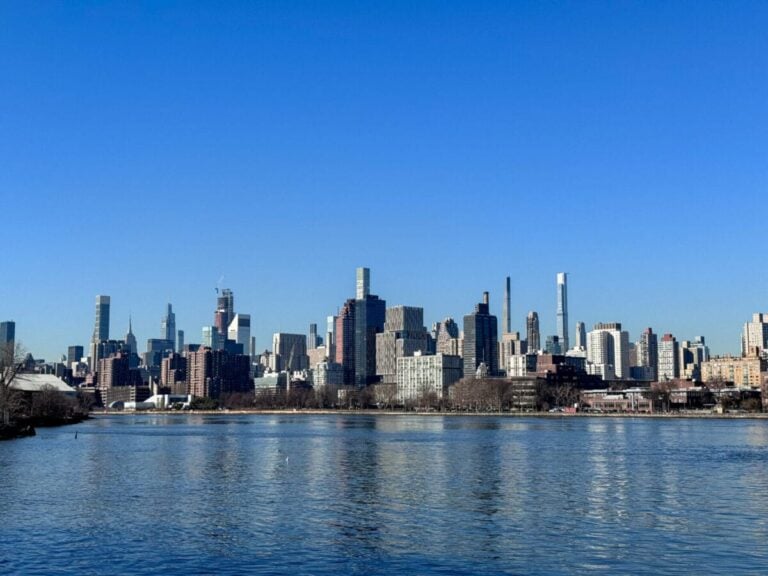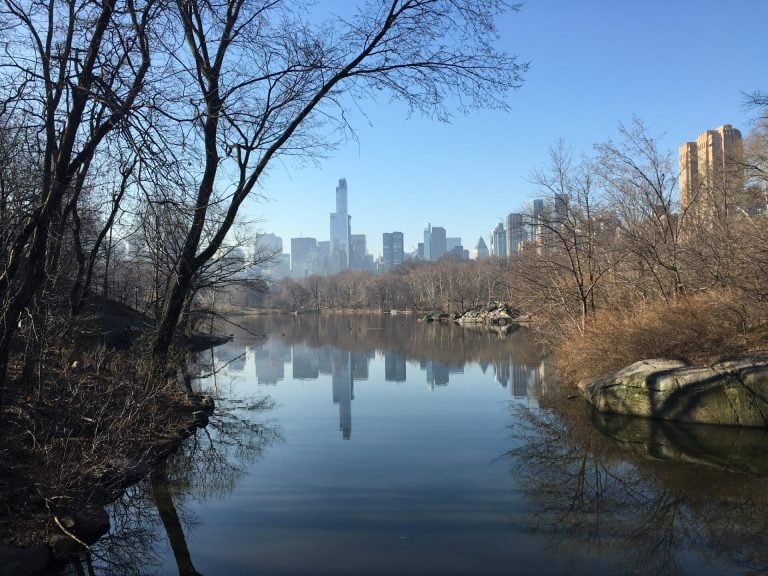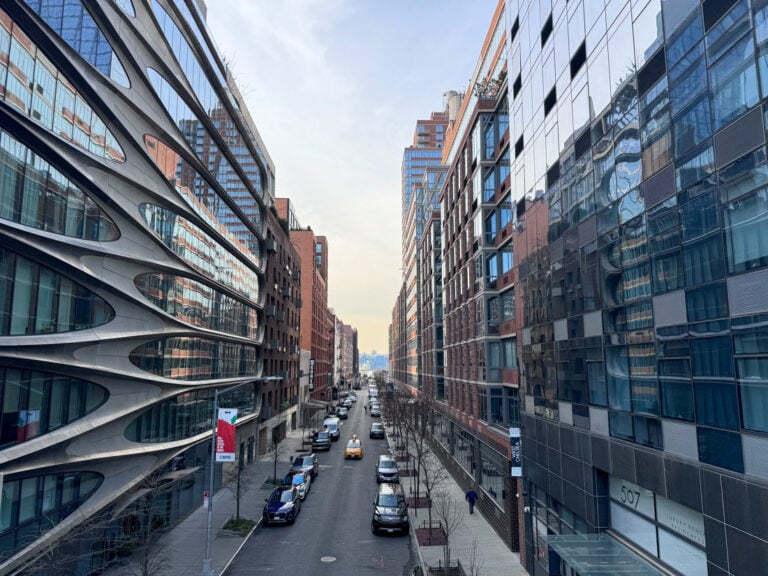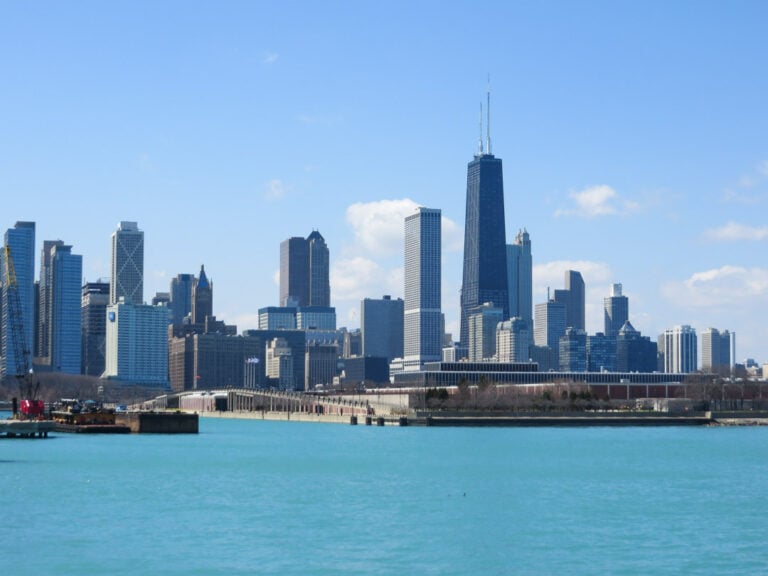The Ultimate 5 Day Utah Road Trip from Las Vegas

Planning a road trip through Utah’s National Parks? I’m here to help! This is one of my favourite road trips I’ve ever done. The diversity of Utah’s scenery and landscapes is breathtaking. It almost feels like being transported to another planet.
Utah is like nowhere else on Earth. With its magnificent red landscape and unusual rock formations, Utah is home to some of the most unique national parks in the United States. It’s the perfect place for a road trip.
In this post, I’ve shared a five-day itinerary through Utah’s National Parks that starts and ends in Las Vegas. This Utah road trip itinerary takes you through Utah’s epic ‘Mighty 5’—the five National Parks of Utah. It’s a jam-packed itinerary, to say the least, but an epic one at that.
I’ve also suggested additional spots for those with more time on their road trip, including destinations a little further afield. The itinerary can also be adjusted to start in Las Vegas and end in Salt Lake City.
This Utah road trip itinerary has a couple of long drives, but I promise it’s worth it!
Ensure you’re prepared for your trip and know what to pack for your journey through Utah.
Here’s my 5-day Utah National Parks itinerary from Las Vegas.
When is the best time of year to visit Utah’s National Parks?
Utah’s National Parks are mostly accessible all year round, but different seasons have advantages.
Spring and fall are the best times of year to visit Utah. There are fewer crowds, and the temperatures aren’t too extreme. You’ll also likely find it’s cheaper to travel to Utah during the spring and fall. I’d recommend the months of April & May and September & October.
It’s worth noting that there might be some snowfall during the spring or fall. This could affect hiking trails and roads. I visited Utah in October, and there was snow in Bryce Canyon. We could still do all the hikes, but it was slippery, to say the least. Oh, and the camping was freezing!
Summer is a popular time to visit, and this is the peak season in Utah. School is out, and families are looking to vacation in the national parks. If you can, I’d avoid the months of July and August. Utah’s National Parks will be crowded, and the temperatures have the potential to be too hot to hike.
It’s also possible to visit Utah in the winter. The national parks are at their quietest between November and March. However, this may not be the best time to visit if you plan to hike. Utah can see a lot of snowfall and ice, meaning the hiking trails are prone to closure in these months. That’s not to say a winter road trip through Utah isn’t possible.
Next up, here’s what to pack for a road trip through Utah.

Utah’s National Parks – The Mighty 5
Utah’s five national parks are known as the Mighty 5. If you’re planning a road trip through Utah, visiting each of the Mighty 5 is the best way to see the true diversity of the landscape.
I’ve shared a brief overview of each of Utah’s Mighty five below.
Zion National Park
Zion National Park is one of the most famous national parks in the United States. It’s a stunning spectacle of towering sandstone cliffs, narrow slot canyons, and lush forested valleys.
Zion is known for several iconic hikes, including the notorious Angels Landing, one of the most dangerous hikes in the USA. Another popular hike in Zion is ‘the Narrows’. This renowned track leads hikers through the Virgin River between sheer slot canyon walls. It’s an absolute must-do hike while in Utah.

Canyonlands National Park
I had never heard of Canyonlands National Park before my Utah road trip, but wow, was I impressed. Canyonlands National Park is the largest national park in Utah. It feels like a never-ending expanse of canyons, rock formations, and desert.
Arriving in Canyonlands felt like landing on another planet. The park is split into four distinct areas, all open to be explored. The Island in the Sky district is one of the most popular areas of the park, offering incredible panoramic views. Another famous district is The Needles, with unusual, striking rock spires and colourful canyons. I spent two days exploring these two districts and was constantly blown away by the scenery.
With just five days in Utah, it would be impossible to see all of Canyonlands, but a trip there is still a must.
Bryce Canyon National Park
Bryce Canyon is the smallest of Utah’s Mighty 5 National Parks. Despite its size, it is still a force in beauty and adventure.
This geological place of wonder is known for its incredible hoodoos – tall rock spires formed by erosion. The park’s main attraction, the Bryce Amphitheatre, is a surreal landscape filled with hoodoos. I’d highly suggest visiting Bryce for sunrise or sunset, where the orange and red rock formations create a stunning display.
Bryce Canyon is also filled with incredible hiking trails, making it an absolute must on any Utah road trip itinerary.

Arches National Park
This destination is my personal favourite national park in Utah. Arches National Park is in the Red Rock Country of south-eastern Utah. It’s next door to Moab, the ‘Adventure Capital of The West’.
Arches National Park boasts an otherworldly landscape. It’s known for its iconic sandstone arches, which have the highest concentration in the world. In fact, Arches National Park is home to over 2,000 natural stone arches. These geological wonders create a surreal landscape, especially during sunrise and sunset.
There are ample hiking opportunities in Arches National Park. One of my personal favourites is Devils Garden area. The landscape here is breathtaking.
Arches National Park is a haven for hiking, nature, and photography lovers.
Capitol Reef National Park
Last, and by no means least, is Capitol Reef National Park. The park is known for the ‘Waterpocket Fold’, a 100-mile-long geological fold in the Earth’s crust. The Waterpocket Fold exposes rock layers, showcasing the region’s geological history over millions of years.
Capitol Reef is also home to petroglyphs – ancient rock carvings. If you’re keen to see petroglyphs, this will be the easiest spot to see them in this itinerary. The park is also home to Cassidy Arch, an impressive natural bridge.

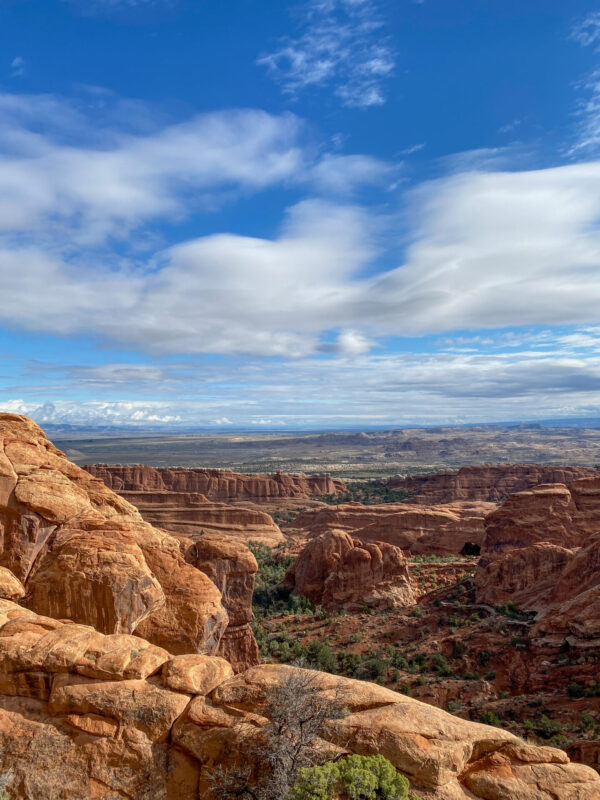
5-Day Utah National Parks Itinerary from Las Vegas
The below itinerary is a suggested 5-day road trip through Utah’s Mighty 5 National Parks from Las Vegas. This itinerary starts and ends in Las Vegas.
I’m going to be honest: 5 days is not enough time to see absolutely everything, but it’s enough time to try. If you have an extra day or two for your Utah National Parks road trip, I’d suggest adding a day at Canyonlands National Park.
I hope the below helps you build your perfect Utah road trip itinerary.
Day one: Drive to Moab and visit Canyonlands National Park
Start your day in Las Vegas, where you will begin your 5-day road trip through Utah’s National Parks.
Today is an early start and a long drive. The idea is to complete a big chunk of the driving today so you can focus the rest of your five days on exploring Utah’s National Parks.
Start as early in the day as possible and head straight to Canyonlands National Park. It will be at least a 7-hour drive, so try to get on the road early enough to give you the afternoon in the park.
Canyonlands National Park is a HUGE and vast area, and it’s going to be impossible to explore it all in this time frame. I’d personally focus on one area of the park. If you don’t have much time in Canyonlands National Park, focus on the Island in the Sky area or the Needles district.
The Island in the Sky Scenic Drive is a good option for a few hours in Canyonlands. This incredible drive gives you a feel for the true vastness and beauty of this area. At the end of the road, there is a short hiking trail to Grand View Point. You’ll be rewarded with stunning views at every moment on this hike.
Another epic spot on the Island in the Sky Scenic Drive is the White Rim Overlook Trail. This is another fun short hike with some of the best views in the area. This hike is particularly amazing at sunset.
Here are some other things to do in Canyonlands National Park:
- Hike to Mesa Arch: this short hike leads you to the incredible Mesa Arch. It’s known for its epic sunrise views.
- Green River Overlook: this viewpoint boasts some of the best views in all of Canyonlands. It’s a convenient short walk from the parking lot and boasts stunning views of the Green Review. I’d highly recommend this spot for sunset.
- Newspaper Rock Historic Monument: if you’re venturing into the Needles district, stop at this monument to admire the incredible petroglyphs. There are some great hiking trails in this area.
- Chesler Loop Trail: this was one of my favourite hikes in Utah. At 10 miles (16km) it’s no short hike, but the diversity of scenery makes it all worthwhile.
Want to explore more hiking opportunities? Here are some of the best hikes in Canyonlands National Park.
Note: As mentioned above, if you have an extra day for your road trip, I’d consider spending more time at Canyonlands National Park. This is a huge and diverse national park with so much to see.

Where to stay in Canyonlands National Park
For night one and night two of your road trip, I suggest staying in the nearby town of Moab. This town is close to both Arches and Canyonlands National Park, making it the perfect spot to stay.
The town is also known as the ‘adventure capital of the West’. It’s full of exciting, adrenaline-filled activities, ample restaurant choices, and plenty of accommodation options.
A good option for campsites in Moab is the Sun Outdoors campsite. I stayed there for two nights. It’s a budget-friendly option and is located relatively close to the town.
There are plenty of hotels and motels in Moab. I’d suggest using booking.com to find the most suitable accommodation. A couple of popular options include the stunning Red Cliffs Lodge and the Wingate by Wyndham.
If you’re travelling during peak season, make sure to book well in advance.
Day two: Arches National Park and Dead Horse State Park
Start the next morning in Arches National Park, just down the road from Moab. This is my favourite of Utah’s ‘Mighty 5’. It’s such a diverse and unusual national park. The scenery is otherworldly, and I’ve never seen anything quite like it.
A whole day in Arches is a reasonable amount of time to see the park’s highlights. There are some epic hikes and viewpoints.
Start the day by heading to Delicate Arch for sunrise. Delicate Arch is one of the best places in Arches National Park to catch the sunrise, so you won’t be alone on the trails. The hike is a 5km (3.1 miles) round trip. Unfortunately, it was cloudy on the day I visited for sunrise. It was still worth it, nonetheless.

After your hike to Delicate Arch, fill your day by exploring other areas of the park.
Here are some of the top things to do in Arches National Park:
- Hike in Devil’s Garden: if there’s one place to visit in Arches National Park, it’s Devil’s Garden. This has to be one of the most beautiful places I’ve ever visited. There’s a range of short hikes as well as longer hikes that allow you to explore this magnificent landscape. While in Devil’s Garden, be sure to hike to Double O Arch. The scenery on route is stunning. The Black Arch Overlook viewpoint is particularly spectacular.
- Drive the Arches Scenic Drive: this popular route connects all the main areas of the park, and you’ll need to drive along it to get to most places. If you’re not a keen hiker, this drive will allow you to see some stunning scenery with zero effort. There are ample viewpoints along the drive. Be sure to check out “Balanced Rock” during the drive.
Note: the Visitor Center in Arches National Park has more information about the park and its history.
I’ve written a whole guide on how to spend a day in Arches National Park.

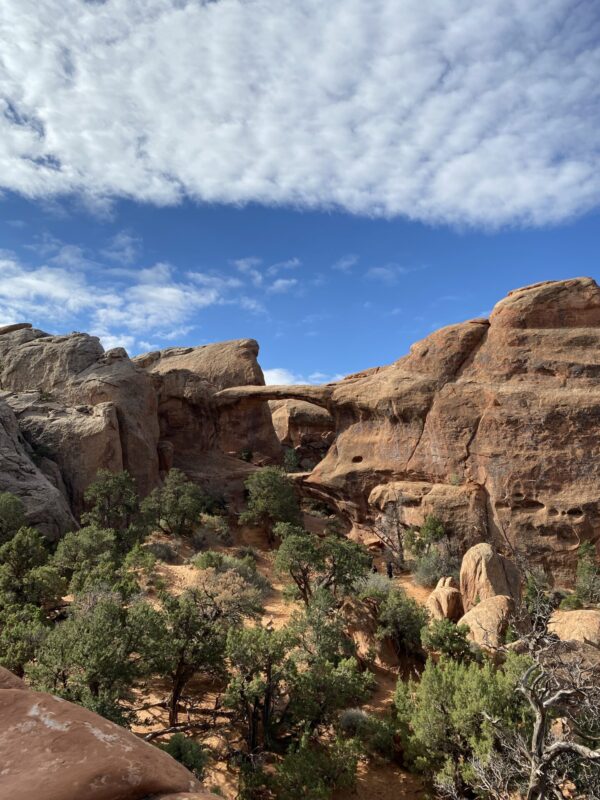
Before heading to your accommodation, consider stopping at Dead Horse Point State Park for sunset. It’s a 30-minute drive (or longer), so a little detour, but wow is it worth it. Dead Horse Point State Park is a vast canyon area overlooking the Colorado River. It gives Grand Canyon vibes and is an excellent alternative for those not visiting there.
Head to the Dead Horse Point overlook for the best views at sunset. The park is also an International Dark Sky Reserve. This means it’s an epic spot for stargazing. Stick around after the sun sets to make the most of the night sky.
It would also be possible to visit Dead Horse Point for sunrise on day 3 if this fits better.
Important note: Arches National Park operates on a timed entry system. This means that between April and October, all visitors entering the park in a vehicle will need to book their slot in advance. This can be done on the official website.
Accommodation options for Arches National Park
Arches National Park is only a few miles from Moab. I suggest basing yourself in Moab on nights one and two, as this will allow you to easily travel between Canyonlands and Arches National Parks. It also means you won’t need to move accommodation after day one.
If you’re keen to camp in Arches National Park, plan well in advance. There is only one campsite in the park, and it’s open between March and October.

Day three: Drive to Capitol Reef National Park
Day three of your 5-day Utah National Parks road trip from Las Vegas is another packed one. Start your day early and make the 2-hour drive to Capitol Reef National Park.
Capitol Reef is famous for its unique geology, petroglyphs, and beautiful orchards. With only 5 days for this road trip, you won’t be able to see everything. However, even with just a few hours, you’ll be able to see Capitol Reef’s highlights.
Spend the next few hours exploring this unique area. Here are some of the best things to do in Capitol Reef National Park:
- Hike to Cassidy Arch: If there’s one thing you do in Capitol Reef National Park, make it this. This 3.1-mile (5km) hike takes you through the canyon to the beautiful Cassidy Arch. This is a distinctive feature in the park, and you can walk right out onto the arch, making for a stunning photo.
- Visit the Gifford Homestead: Don’t leave Capitol Reef without trying a pie from the Gifford Homestead. This famous café is known for its sweet and savoury treats, with cinnamon rolls and pies being a particular favourite. The farmhouse is near the famous orchards so grab a snack and take a stroll through the trees.
- Admire the petroglyphs: Capitol Reef is known for its fascinating red rocks and geology, but it’s also home to some incredible ancient petroglyphs. The rock carvings are thought to have been created between 600 and 1300 AD.
- Capitol Reef Scenic Drive: If you have the time, drive the famous Scenic Road through Capitol Reef. This 7.9-mile (12.7-km) drive boasts breathtaking scenery. Several stops along the way include scenic viewpoints and unique rock formations. As of March 2025, the cost to enter the road in a private vehicle is $20.
Once you’ve finished your day in Capitol Reef National Park, start the 2-hour drive to Bryce Canyon National Park. The reason you’re driving there tonight? To catch the magnificent sunrise in Bryce Canyon the following morning.

To get from Capitol Reef to Bryce Canyon, you can drive the slightly longer scenic drive on Route 12. This is known to be one of the most beautiful drives in America. The drive will take about 2 hours and 30 minutes without stopping, but there are many scenic viewpoints on the route.
Route 12 is also home to Grand Staircase-Escalante, a National Monument in Utah. I’ve spoken more about this below, but it’s an epic place to stop if you have the time. Realistically, you’ll struggle to fit this into this itinerary without sacrificing something else, but I’ll leave that up to you!
Of course, you can opt to spend the night in the Capitol Reef area instead. However, with only 5 days to see Utah, I’d suggest you keep moving and make the drive to Bryce Canyon on day 3. If you do choose to stay in Capitol Reef, it’s home to some epic, and I mean EPIC, stargazing.

Accommodation options in Bryce Canyon
Seeing the sunrise in Bryce Canyon is a bucket list activity, so I highly suggest staying as close to the park as possible.
For camping, there is the option to camp inside the park at either of the two campgrounds.
The only hotel inside Bryce Canyon National Park is Bryce Canyon Lodge. You’ll need to plan well in advance, and it’s not exactly budget-friendly, but you’ll be in a prime spot for the next day’s adventures.
Bryce Canyon City is the closest town to the national park. It is just a few minutes from the park’s entrance and visitor center. Accommodation here is generally more affordable. The Bryce Canyon Shuttle also picks visitors up from here. There is a grocery store and other facilities.
Day four: Bryce Canyon National Park
Next up is the smallest of Utah’s National Parks – Bryce Canyon. Bryce Canyon is a spectacular spot in southern Utah. It’s known for its collection of hoodoos and tall and narrow rock spires formed through erosion. Bryce Canyon is one place where you must “pinch yourself”. It’s beautiful beyond words can describe.
Some people only pass through Bryce Canyon on their Utah road trip, but I suggest spending a full day in the park. It’s a truly wondrous place you want to see as much as possible.
Bryce Canyon is particularly beautiful in the winter months. The viewpoints over the amphitheatre with a snow-covered landscape are breathtaking, especially at sunrise.
Begin your day in Bryce Canyon by catching sunrise over the Amphitheatre. The best spots are Sunrise Point and Sunset Point. There is a convenient parking lot meaning you won’t need to walk far, but get there early to ensure you get a space.

The sunrise I saw in Bryce Canyon is genuinely one of the best sunrises I have ever seen. There was something so magical about watching the sun rise above the horizon and the amphitheatre lighting up gold and red.
Bryce Canyon is a hiker’s paradise and after watching the sunrise, hit the trails to see more of this phenomenal destination.
Here are some of the best hikes in Bryce Canyon:
- Navajo Loop and Queen’s Garden: this is without a doubt one of the best hikes in Utah. The Navajo Loop trail is a 1.5mile (2.4km) trail that takes you down the famous switchbacks known as Wall Street. To see more of the incredible Bryce Amphitheatre, continue your hike on the Queen’s Garden Trail. This will get you up close and personal with those iconic red hoodoos.
- Bryce Point and the Peekaboo Lookout: this 5.2 mile (8.3km) hike can also be linked with the Navajo Loop trail. It’s a great way to walk amongst the hoodoos.
- Rim Trail: if you’re not a keen hiker but want to see more of Bryce, consider a stroll along the Rim Trail. The trail is 5.5miles (9.8km) long but you can walk as much or as little as you like. I’d suggest parking your car in the Sunrise Point Parking Lot and having a stroll from there. It’s a relatively easy hike that all can enjoy.
- Inspiration Point: before leaving Bryce Canyon, make a quick stop at Inspiration Point for more incredible views. This is one of my favourite viewpoints in the park.
I’ve written all about how to spend a day in Bryce Canyon National Park to help you plan your trip.

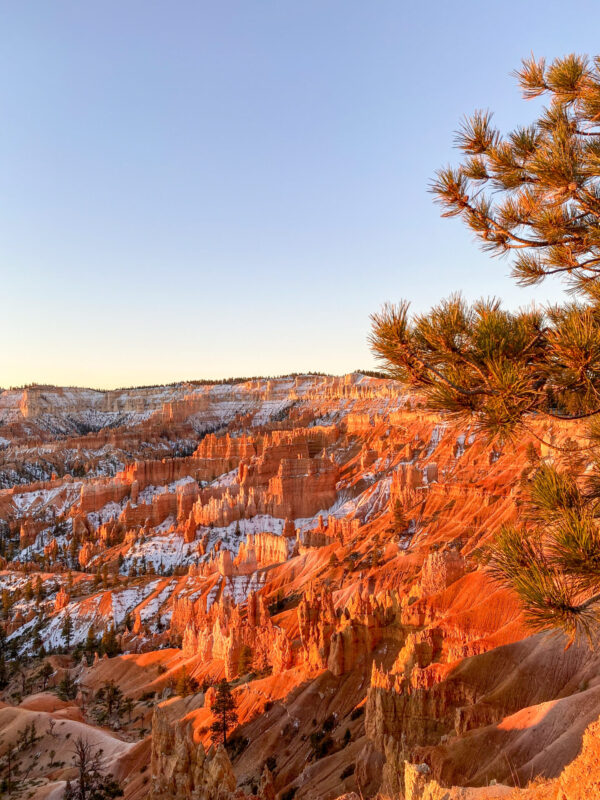
After finishing your day in Bryce Canyon, drive to Zion National Park for the final day of your road trip through Utah’s National Parks. This drive should take you around 2 hours depending on traffic.
Note: you could always drive to Zion in the morning on day five. There’s lots to see in Zion however and if you’re keen to hit the trails, I’d suggest getting there this evening so you can spend a full day in the park.
Accommodation options in Zion National Park
Zion National Park is one of the busiest parks in America, so finding accommodation can be a challenge.
If you want to stay inside Zion National Park, your only option is Zion Lodge. This highly rated hotel is a popular option as it’s conveniently located near several hiking trails.
Zion National Park also has three campsites. I stayed at the Watchman Campground which is very well located. You normally need to book at least six months ahead of time to get a space here.
The nearby towns of Springdale and Cedar City also have ample accommodation options. I recommend using Booking.com to find your accommodation.
Day five: Zion National Park
The final stop of your Utah National Parks road trip is the iconic Zion National Park in Southern Utah. Zion is known for its dramatic red rock landscapes, towering cliffs and narrow slot canyons. Start your day as early as you can as there are so many things to do and see in Zion.

The famous Angels Landing hike is one of the best things to do in Zion. This stunning hike is known to be one of the most dangerous hikes in the United States. With its narrow ridges and cliff faces, it’s not for the faint of heart. The hike requires you to ascend nearly 1,500 feet above the canyon floor up a series of switchbacks known as Walter’s Wiggles. Once at the top, start the nerve-wracking walk along the narrow ridge.
At the summit of Angels Landing, you’ll be rewarded with panoramic views of the Zion Canyon, the Virgin River and surrounding red rock landscape. This is, without a doubt, one of the best hikes in America. Due to its popularity, the National Parks Service recently introduced a permit system. You won’t be able to do this hike without a permit.
Another iconic hike in Zion National Park is ‘The Narrows’. This hike takes you through the Virgin River’s narrow slot canyons (hence the name). There is no other hike like it, and it’s an absolute must on your Zion itinerary.
The Narrows hike requires wading and, at times, swimming through the river itself. You can hire equipment for the hike right outside the park.
Here are some other things to do in Zion National Park:
- Emerald Pools hike: The hike starts at the famous Zion Lodge. There are three different pools: lower, middle and upper. You can walk to just one or complete the full trail, which is a total of 3.1 miles (5km). The walk boasts stunning views, including waterfalls, panoramic vistas and, of course, the pools themselves.
- The Watchman Trail: This is a shorter hike (2.7 miles) but is stunning nonetheless. It’s located near the park’s entrance, so it’s a great option for those with less time. The trailhead is right by the Visitor Center and the Watchman Campground.
- Ride the shuttle bus: If you’re visiting Zion during peak season, you’ll need to take the shuttle bus to get around the park. A ride on the shuttle bus is a great way to explore the park with minimal effort. There are incredible views around every corner.
- Stargazing: Zion is known for its epic stargazing. Grab a blanket and admire the night sky, or join a tour to learn more about this wondrous night sky.
Discover more hikes in Zion National Park.
Important note: private vehicles are not allowed into Zion National Park during the peak season (generally March to November). You’ll need to leave your car in a parking lot and catch the Zion shuttle bus to get around.
After ending your day in Zion, you’ve finished your 5-day road trip through Utah’s National Parks. Head back to Las Vegas or stay an extra night in Zion.

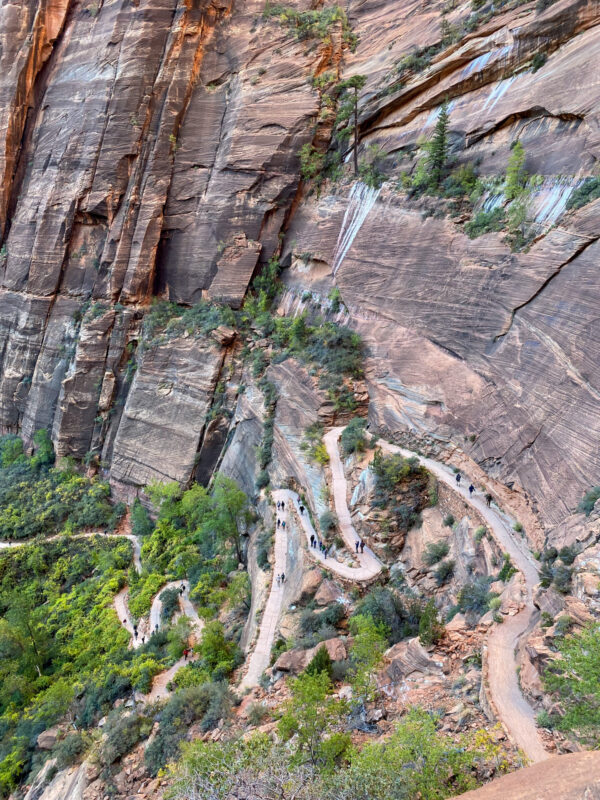
Utah Road Trip: Las Vegas to Salt Lake City Itinerary
Planning a Las Vegas to Salt Lake City road trip? The above itinerary can be adapted to suit that.
Here’s what I would do if I were driving from Las Vegas to Salt Lake City.
Stop one: Zion National Park
Start your road trip from Las Vegas to Salt Lake City by visiting Zion National Park.
Stop two: Bryce Canyon National Park
Next up, spend a day exploring Bryce Canyon. Be sure to catch one of the iconic sunrises.
Stop three: Capitol Reef National Park
Move on to the stunning Capitol Reef. If you have the time, take Route 12 and make a stop as Grand Staircase-Escalante.
Stop four: Moab
The next stop is Moab. Spend a couple of days exploring Canyonlands and Arches National Parks.
Stop five: Salt Lake City
Finish your epic road trip from Las Vegas in Utah’s capital, Salt Lake City. Consider visiting the Bonneville Salt Flats to see more of Utah’s diverse landscapes.
Other places to visit on a road trip from Las Vegas
If you have an extra day or some extra time for your road trip, consider one of these additional stops.
Bonneville Salt Flats (Utah)
The iconic Bonneville Salt Flats are one of Utah’s most iconic and surreal landscapes. The Salt Flats are about 110 miles from Utah’s capital, Salt Lake City. This unique destination features a vast expanse of salt crust, creating an almost otherworldly environment.
This 30,000 acre spot requires some planning to visit, but it’s well worth it.

Grand Staircase-Escalante (Utah)
The Grand Staircase-Escalante is a National Monument in Utah. Although not officially a national Park, a stop at the Grand Staircase-Escalante is a must if you have the time.
The area is home to some incredible hikes and scenery. With waterfalls, canyons, red rock cliffs and narrow slot canyons, Grand Staircase-Escalante is an epic spot on a Utah road trip.
While here, consider hiking to Lower Calf Creek Falls. The track is 6.2 miles (10km) round trip and takes you to a beautiful waterfall. It was one of my favourites hike in Utah. There is also information about the area on route.
The National Monument can easily be added to any Utah itinerary. The park is located on Route 12 between Capitol Reef and Bryce Canyon.

Red Canyon (Utah)
Southern Utah is home to Red Canyon, an incredible display of hoodoos, spires and cliffs. Red Canyon is often overlooked by the nearby Bryce Canyon, but it’s worth visiting if you have the time.
It’s right in the heart of Dixie National Forest with ample hiking trails. Red Canyon can be found between Bryce Canyon and Zion National Parks.
Valley of Fire State Park (Nevada)
Less than an hour from Las Vegas is the Valley of Fire State Park. If seeing petroglyphs is high on your list, then you’re in luck. The petroglyphs here are estimated to be around 2000 years old. The park is also home to the iconic Fire Wave, a vibrant sandstone rock formation.
Thinking of visiting Valley of Fire State Park. Here’s everything you need to know.
Hoover Dam (Nevada)
The Hoover Dam is an engineering marvel which spans the border between Arizona and Nevada. It’s a bit of a detour from Utah to reach here, but if you have the time, I’d highly recommend it. The scale of the Hoover Dam is mind-boggling. You can walk across the Hoover Dam or opt to join a guided tour.
The Grand Canyon (Arizona)
The Grand Canyon is one of the world’s most recognisable natural landmarks. This huge canyon is a whopping 1.217 million acres. It’s possible to visit the Grand Canyon as part of a Utah road trip. I’d add this in as your first stop out of Las Vegas (or last stop when returning).
Want to see more of Arizona, including the famous Monument Valley or Horseshoe Bend? Consider a road trip through Arizona.
Did you find this 5-day itinerary for Utah’s National Parks from Las Vegas helpful? Share on social media below or save for later.

